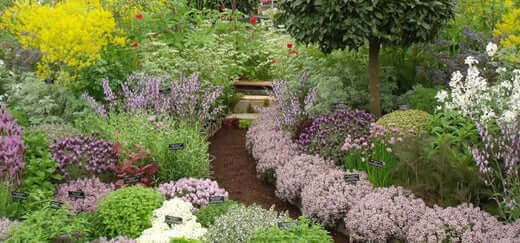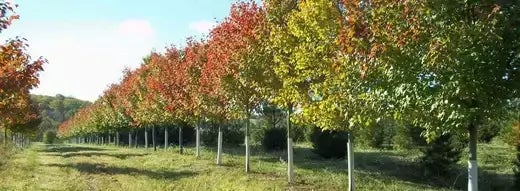Stop Soil Erosion with Vines
Some use retaining walls to stop soil erosion, but one of the best ways to solve the problem is to prevent soil erosion with vines. Stabilize steep banks with these plants. They hold soil tight and anchor it together. Ivy grows densely around some soil types rooting along with the soil, locking soil that would otherwise wash away.
People with homes sitting on hills and slanted areas to stop the erosion of their land for centuries have used Ivy. Thousands of acres of property wash away yearly, and damage to a home's foundation can be affected by this change in soil location. Plants offer a valuable asset in stopping the loss of soil. Vinca minor is a lovely plant that grows and clings to the earth. It is a running plant and holds the most excellent sand. This flowering plant is called Periwinkle. English ivy vines.
Vines that will help with soil erosion.
English ivy vines are some of the prettiest. They are easy to grow and are seen in buildings everywhere. This plant is native to Europe and Asia but has become commonplace in many countries. They are beautiful but can overtake shrubbery. Hedges and trees can easily fall prey to English ivy. In established homes, you may see English ivy growing up walls at will. Seasoned gardeners know this is a beautiful way to stop soil erosion.
Stabilize steep banks with Periwinkle. English ivy is one of the easiest plants to grow. They can be rooted by merely placing the vines in water and take almost no nurturing. However, they will run wild if not trimmed.
Soil erosion is a severe problem in flood areas, hilly properties, and areas of heavy rain. After years of soil decay without some control, a homeowner may find property damage in the thousands of dollars. Vinca minor is the easy way out. Plant English ivy, save money, and your property will look great, offering your home a look of distinction.
Stabilize steep banks with this affordable easy-to-grow plant. It does not take an expert gardener to place these plants at strategic points. They are much less expensive than a new brick wall and a lot less work, and they may save you expensive property damage. Growing soil erosion is difficult to repair, and the damage to buildings and property drainage takes time and money. Planting a running plant is convenient and takes only a little of your time. Vinca minor can be purchased online or at any garden shop. Periwinkle. English ivy vines are star-shaped and can be planted in a heavy shade or a sunny spot. That makes the plant easy to grow in any problem area you might have.
Steps to Prevent Soil Erosion
Keeping your soil safe from erosion is essential for maintaining a vibrant and productive landscape, whether nurturing a garden, managing farmland, or enhancing your property. Erosion strips away nutrient-rich topsoil and affects water quality and plant health. The good news is that there are straightforward actions you can take to protect and enrich your soil.
Plant roots offer the most natural protection against erosion. Opt for ground covers, native grasses, or shrubs with robust root systems that firmly anchor the dirt, stopping it from flying away during heavy rainfall. Creeping plants like vinca or clover are excellent choices for slopes, while ornamental grasses such as switchgrass or bluestem will bring beauty and stability to flatter areas.
Mulching is another highly effective technique. Apply organic mulch around bare soil like shredded bark, straw, or pine needles. This layer acts as a protective blanket, diminishing the force of raindrops, conserving moisture, and encouraging the growth of beneficial microorganisms that enrich your soil.
If you have areas prone to runoff, consider implementing terraces. By creating flat steps on a hillside, you can slow water movement, allowing it to soak into the ground instead of washing it away. Using natural materials like logs or stones for the retaining walls will help blend your structures seamlessly into the landscape while supporting the soil.
How to Stop Soil Erosion on Steep Slopes
For steep slopes, start by installing erosion-control mats or biodegradable netting. These materials help anchor the soil until the plants become established. Pair these mats with deep-rooted plants such as black-eyed Susan or wildflowers to form a long-lasting barrier against erosion.
Creating a rain garden at the base of the slope can also significantly reduce erosion. These gardens capture and filter runoff water, helping stabilize the soil and attracting pollinators and wildlife. Native plants, like swamp milkweed or Joe Pye weed, thrive in rain gardens and require minimal care once established.
Lastly, be mindful of your watering habits. Overwatering contributes to runoff and erosion and is wasteful. Instead, consider using soaker hoses or drop irrigation systems to deliver water straight to the bases, which helps prevent soil disturbance.
These strategies can prevent soil erosion and create a healthy, sustainable landscape. Your soil can remain rich and safeguarded for future generations with effort and careful planning.
Building a Garden That Endures: Strategies for Erosion Resistance
Building an erosion-resistant garden requires more than selecting plants with strong root systems; it also demands careful planning, effective soil management, and innovative material choices. The rapid movement of rainwater or irrigation water across the land surface leads to erosion, which removes topsoil and creates gullies or bare areas. Garden enthusiasts must implement techniques that improve soil water retention while stabilizing it to maintain better water flow management. A combination of soil amendments, strategic landscaping, structural supports, and sustainable watering practices helps establish a space that preserves its structure and supports continuous growth.
The initial step in preventing erosion involves analyzing the inherent slope of the landscape. Heavy rainfall causes water to speed down steep slopes, carving channels into the earth and removing sediment. Dividing the slope into multiple smaller-level terraces provides an effective solution to manage erosion. Low retaining walls or stepped raised beds help reduce flowing water force while creating flat areas that allow rainfall to soak into the soil rather than running away. Using terracing prevents water pooling at the bottom of slopes, reducing waterlogging and soil erosion incidents. The effort required to construct terraces pays off through enhanced stability, which justifies the investment in materials and time.
Selecting appropriate structures to maintain soil stability remains critical in effective soil management. Retaining walls shield vulnerable areas in steep landscapes by holding back soil that would otherwise slide forward. Wood, natural stone, and engineered blocks are viable materials for building support structures. Walls need proper drainage behind them to avoid excessive water pressure buildup. Water pressure can be managed behind retaining walls by incorporating small openings or using materials that let water through while keeping soil contained. Retaining properly installed walls provides long-lasting solutions and effectively diminishes erosion risk.
The focus on soil integrity needs to extend beyond terracing and walls. Using non-chemical techniques, such as adding organic matter to compacted soil, enables water infiltration instead of surface runoff. Soil structure benefits from organic matter, increasing porosity and moisture retention while reducing surface runoff. The addition of compost and decomposed materials regularly boosts soil nutrients while providing a better habitat for beneficial life forms like earthworms and microbes. Through their actions, these organisms create further soil aeration, which maintains a crumbly structure that helps water penetrate the ground.
Mulching functions as an effective erosion management tool that operates through straightforward principles. You can prevent soil displacement by using mulch to cover bare soil since this reduces the force of raindrops hitting the ground, which leads to soil displacement. Mulch is a barrier to weed growth and moisture retention to prevent soil from becoming dry and cracked, which becomes susceptible to erosion. As organic mulches decompose, they enrich the soil and improve its resilience. Select permeable materials for paths experiencing heavy foot traffic that enable rainwater to penetrate the ground instead of running off the surface.
Managing water flow remains essential to stop erosion from happening. Gentle swales and shallow depressions, which capture runoff and allow water to seep into the soil slowly, represent an effective strategy. Rain gardens or infiltration trenches can serve as temporary holding areas for water collected by swales where water remains without causing harm. Careful runoff management decreases water speed while distributing pressure across a wider area. A methodical management system reduces land erosion while maintaining steady moisture availability during dry spells.
Vegetation is essential in erosion prevention because mature plants' root systems bind soil particles together, which keeps them fixed in their location. When developing a garden that guards against erosion, you must pick durable plant species suited to your area, but your real success comes from establishing biodiversity. From ground-level foliage to deep-rooted shrubs, plant growth varieties protect soil layers and distribute water movement stresses. Every vegetation layer acts as a buffer that slows raindrops from reaching the ground while roots anchor the soil.
Consistent long-term care maintains the health of gardens designed to resist erosion. Inspecting terraces, retaining walls, and drainage features regularly allows you to find and address problems such as cracks or blockages early. The integrity of the soil remains intact through periodic mulch replacement and ongoing addition of organic materials. As your garden develops and matures, the collaboration between fertile soil, strategically placed structures, and robust plant life reduces erosion risks. Focusing on managing slope conditions and water flows together with soil health will enable gardeners to develop a stable and vibrant space throughout the year without identifying particular plant species.
Read more

Some Reasons To Grow A Herb GardenThese days, it seems there is a pill for every malady afflicting the human race. Many people benefit from these medications, but these medications come with side e...

Shopping Online For Trees - Convenient and AffordableShopping Online For TreesShopping online for trees isn't just the ultimate experience inconvenience. It's also more affordable. Online nurseries...


